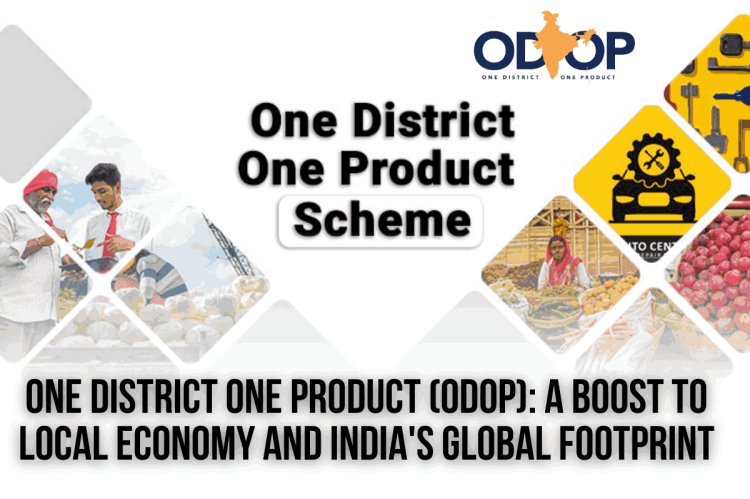One District One Product (ODOP): A Boost to Local Economy and India's Global Footprint
The One District One Product (ODOP) initiative is a significant program launched by the Government of India aimed at promoting district-specific products to drive regional economic development, preserve traditional industries, and enhance export potential. By leveraging unique local resources, skills, and cultural heritage, ODOP creates new opportunities for employment and entrepreneurship. This article explores the origins, objectives, key features, success stories, challenges, and future prospects of the ODOP program, emphasizing its role in boosting India's economy and global footprint through the promotion of local products.

Introduction
The One District One Product (ODOP) initiative is a flagship program launched by the Government of India with the goal of fostering balanced regional development by promoting local products unique to each district. The idea behind ODOP is simple but powerful: every district has a product that is emblematic of its culture, resources, and skills. By focusing on promoting these products, the initiative aims to increase local employment, enhance export potential, and preserve traditional industries.
ODOP aligns with India’s broader economic objectives of self-reliance (Atmanirbhar Bharat), Make in India, and Vocal for Local campaigns. The program provides a strategic framework for driving the economic development of districts, increasing the value addition to their products, and encouraging entrepreneurship at the grassroots level.
This article delves into the origins and objectives of the ODOP program, its implementation framework, key successes, challenges, and the way forward in making India’s districts hubs of economic development through unique products.
Origins of the ODOP Initiative
The concept of ODOP has its roots in Japan’s One Village One Product (OVOP) initiative, which began in the 1970s. The OVOP model proved successful in transforming rural economies in Japan by promoting specific local products, encouraging entrepreneurship, and helping villages achieve self-sufficiency. Inspired by this model, the Indian government adapted the idea to suit the local context.
ODOP was initially launched in the state of Uttar Pradesh in 2018, where it aimed to promote traditional crafts and industries that were unique to the various districts in the state. Based on its success, the Central Government decided to expand the program nationwide under the broader ODOP initiative, which is now being spearheaded by various ministries, including the Ministry of Commerce and Industry, the Ministry of Food Processing Industries, and the Ministry of Textiles, among others.
Objectives of the One District One Product Initiative
The key objectives of the ODOP initiative include:
1. Boosting Regional Economic Development: By promoting products that are indigenous to specific districts, ODOP aims to spur economic growth and employment generation at the local level. This approach helps in reducing regional disparities by focusing on local strengths.
2. Preservation of Traditional Crafts and Industries: Many districts in India are known for their traditional crafts, art forms, and industries, which are often at risk of disappearing due to modern industrialization. ODOP helps preserve these unique industries by providing a platform for their promotion and commercialization.
3. Enhancing Export Potential: ODOP not only promotes local products domestically but also looks at enhancing the global market reach of these products. This objective is tied to increasing the export potential of India’s traditional crafts, agricultural products, and processed goods.
4. Promoting Entrepreneurship and Skill Development: By focusing on local products, ODOP encourages entrepreneurship within districts. Small and medium enterprises (SMEs) are given the support they need to thrive, and local artisans and entrepreneurs are empowered through skills development and access to markets.
5. Value Addition to Local Products: Through modern technology, design intervention, and branding, ODOP seeks to add value to local products. This helps make these products competitive in both national and international markets.
6. Sustainability and Inclusivity: The initiative focuses on inclusive growth by promoting sectors that often involve marginalized communities, including women artisans and rural populations. The program also seeks to promote environmentally sustainable practices in the production process.
Key Features of the ODOP Program
1. District-Level Focus
The core feature of ODOP is its focus on identifying a product that each district in India can promote. These products are often linked to the district's cultural heritage, natural resources, or local skills. Examples include Banarasi silk from Varanasi, Pashmina from Kashmir, Mangoes from Ratnagiri, and Kanchipuram sarees from Tamil Nadu.
2. Product Diversification
ODOP focuses on a wide range of sectors, from handicrafts and textiles to agriculture, food processing, and manufacturing. This product diversity ensures that different regions of India, each with its unique resources, get equal representation in the national and global markets.
3. Financial and Technical Assistance
The government provides financial support through various schemes and collaborations with banks. This includes loans at subsidized rates, grants for technology upgradation, and market promotion assistance. Additionally, ODOP facilitates skill development programs to help local artisans and entrepreneurs improve their craftsmanship and technical expertise.
4. Market Linkages and E-commerce
ODOP emphasizes connecting local products to larger markets. This includes participation in domestic trade fairs, export promotion councils, and tie-ups with e-commerce platforms like Amazon and Flipkart, which feature ODOP products in dedicated sections. These market linkages ensure that local artisans and producers gain access to both national and international consumers.
5. Branding and Packaging
One of the most significant aspects of ODOP is branding. The program focuses on creating a distinct identity for each product, often tied to its geographical origin. This is supplemented with improved packaging and marketing strategies that make the product more appealing and competitive in the market.
6. Export Promotion
ODOP products are promoted globally through trade expos, international delegations, and collaborations with international buyers. The government also facilitates these products' registration under the Geographical Indications (GI) Act, which offers them legal protection and boosts their export potential.
Success Stories of the ODOP Initiative
ODOP has already made notable strides in improving the livelihood of local artisans and promoting Indian products in global markets. Some of the success stories from the program include:
1. Banarasi Silk Sarees
The Banarasi silk sarees from Varanasi have long been associated with India's rich cultural heritage. Through the ODOP initiative, these sarees have gained new markets globally. The initiative has helped improve the production techniques and quality of Banarasi silk while also supporting weavers in accessing better marketing platforms, including e-commerce websites.
2. Chikankari from Lucknow
Lucknow’s Chikankari embroidery is another ODOP success story. By connecting local artisans with larger markets and facilitating technology upgradation, the program has significantly enhanced the global appeal of this delicate art form. Chikankari products are now exported to various countries, including the U.S., U.K., and Middle Eastern markets.
3. Alleppey Coir Products
In Kerala, the ODOP initiative has promoted the famous coir products from Alleppey. These eco-friendly products, including mats and ropes, have found a niche in international markets, thanks to the government’s support in terms of product improvement, packaging, and branding.
4. Agricultural Products
ODOP has also promoted the export of various agricultural products such as Ratnagiri mangoes and Darjeeling tea. By improving the supply chain and export processes, the initiative has ensured that these products reach a global audience, thus enhancing farmers' incomes.
Challenges Facing the ODOP Initiative
While ODOP has seen considerable success, it faces certain challenges:
1. Logistics and Supply Chain Bottlenecks
Ensuring efficient transportation and supply chain management remains a significant challenge, especially in remote districts where infrastructure is underdeveloped. Poor logistics can hinder the timely delivery of products to national and international markets, affecting profitability.
2. Awareness and Outreach
Many artisans and producers are not fully aware of the support and benefits offered under ODOP. Expanding outreach and educating local communities about the program's benefits is essential for its broader success.
3. Global Competition
While ODOP aims to promote India’s unique products globally, many of these items face stiff competition from similar products produced in other countries. Maintaining quality, cost competitiveness, and innovation is crucial for sustaining global demand for ODOP products.
4. Access to Technology
For many small-scale artisans and producers, access to modern technology for improving production processes and product design remains limited. Without technology upgradation, it can be difficult for local products to compete on a global scale.
Future Prospects of the ODOP Initiative
Despite the challenges, ODOP holds immense potential for contributing to India’s economic growth and promoting sustainable, inclusive development. Some of the key future directions for ODOP include:
1. Increased Focus on E-commerce
With the rise of online shopping, expanding the presence of ODOP products on e-commerce platforms, both domestic and international, can significantly boost sales. This will provide local producers direct access to global consumers, bypassing intermediaries.
2. Global Branding of Indian Products
Strengthening the branding of ODOP products with Geographical Indications (GI) can help them compete better in global markets. GI certification offers a distinct identity and often justifies a premium price for the product.
3. Expansion of Financial Support
By expanding credit facilities, reducing interest rates, and offering more grants for product development and marketing, the government can ensure that small-scale producers have the financial backing to grow their businesses.
4. Strengthening Global Market Access
Strengthening partnerships with international buyers and retailers can enhance the global reach of ODOP products. Participation in international trade fairs and exhibitions will further boost export opportunities.
Conclusion
The One District One Product (ODOP) initiative is a transformative approach to local economic development that leverages India’s rich cultural heritage and natural resources. By focusing on unique district-specific products, ODOP not only preserves traditional crafts and industries but also promotes regional development, encourages entrepreneurship, and enhances export potential.












